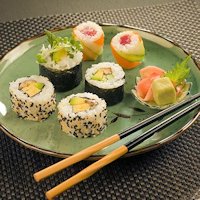
|
Some Common Myths Thought to be True - Myth 25
Myth 25: Sushi means "Raw Fish"
Sushi is a Japanese food consisting of cooked vinegared rice
combined with other ingredients, usually raw fish or other seafood.
Ingredients and forms of sushi presentation vary widely, but the ingredient
which all sushi have in common is vinegared rice. The vinegared rice is also
referred to as shari and sumeshi. Raw meat (usually but not
necessarily seafood) sliced and served by itself is sashimi. Many non-Japanese
use the terms sashimi and sushi interchangeably, but they are not synonymous.
Sushi refers to any dish made with vinegared rice.
|
| Sushi or Saahimi | |
|
Sushi actually is characterized by a slightly sweet, sticky rice, made with a
sweet vinegar and rice combination, usually lined with seaweed or kelp, called
nori, and then the ingredients are placed in the center and the rice and
seaweed are wrapped around the ingredients into a cylindrical roll. Once the
sushi is rolled, it can be cut into the familiar circles served in restaurants
and stores in America.
|
|
| ⇦ Back to Myth 24 Return to Myth Choices Page 2 On to Myth 26 ⇨ | |